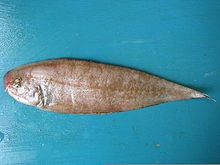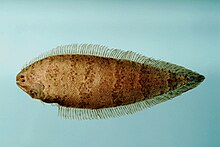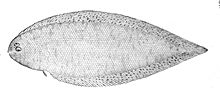Dog tongues (fish)
| Dog tongues | ||||||||||||
|---|---|---|---|---|---|---|---|---|---|---|---|---|

|
||||||||||||
| Systematics | ||||||||||||
|
||||||||||||
| Scientific name | ||||||||||||
| Cynoglossidae | ||||||||||||
| Jordan , 1889 |
The dog tongues (Cynoglossidae ( Gr .: kyon = dog, glossa = tongue)) are a family from the order flatfish (Pleuronectiformes). They live worldwide in tropical and subtropical regions in the sea and in the brackish water of estuaries . Five species live in fresh water. Many species are fished commercially. In the North Sea occurring dog tongue ( Glyptocephalus cynoglossus ) does not belong to this family, but to the plaice (Pleuronectidae).
features
Dog tongues have a slim shape for flatfish. The very small, closely spaced eyes are on the left side of the body. The dorsal , the pointed caudal and the anal fin are fused to form a fin edge. The dorsal fin begins in front of the eyes. Pectoral fins are missing, only with Symphurus a fine membrane remains. The ventral fin on the underside has four fin rays on the center line of the body. The edge of the gill cover is hidden under the skin and scales. The number of vertebrae is 42 to 78, usually 9 to 10 trunk and 33 to 66 tail vertebrae. Most species stay under 30 centimeters, the largest becomes 48 centimeters long.
Systematics
There are two subfamilies, three genera and over 140 species:
Subfamily Cynoglossinae
In the subfamily Cynoglossinae, the head protrudes above the arched mouth. The lateral line organ is well developed, especially on the eye side. The ventral fin on the side of the eye has grown together with the anal fin. The species of the subfamily Cynoglossinae mostly live in shallow water, five mainly in rivers and three only in fresh water. The subfamily includes two genera with almost 70 species.
- Genus Cynoglossus Hamilton, 1822 , fringed lips.
- Cynoglossus abbreviatus Gray, 1834
- Cynoglossus acaudatus Gilchrist, 1906
- Cynoglossus acutirostris Norman, 1939
- Cynoglossus arel Bloch & Schneider, 1801
- Cynoglossus attenuatus Gilchrist & Thompson, 1917
- Cynoglossus broadhursti Waite, 1905
- Cynoglossus browni Chabanaud, 1949
- Cynoglossus cadenati Chabanaud, 1947
- Cynoglossus canariensis Steindachner, 1882
- Cynoglossus capensis Kaup, 1858
- Cynoglossus carpenteri Alcock, 1889
- Cynoglossus crepida Fricke et al., 2017
- Cynoglossus cynoglossus Hamilton, 1822
- Cynoglossus dispar Day, 1877
- Cynoglossus dollfusi Chabanaud, 1931
- Cynoglossus dubius Day, 1873
- Cynoglossus durbanensis Regan, 1921
- Cynoglossus feldmanni Bleeker, 1853
- Cynoglossus gilchristi Regan, 1920
- Cynoglossus gracilis Günther, 1873
- Cynoglossus heterolepis Weber, 1910
- Cynoglossus interruptus Günther, 1880
- Cynoglossus itinus Snyder, 1909
- Cynoglossus joyneri Günther, 1878
- Cynoglossus kapuasensis Fowler, 1905
- Cynoglossus kopsii Bleeker, 1851
- Cynoglossus lachneri Menon, 1977
- Cynoglossus lida Bleeker, 1851
- Cynoglossus lighti Norman, 1925
- Cynoglossus lineolatus Steindachner, 1867
- Cynoglossus lingua Hamilton, 1822
- Cynoglossus maccullochi Norman, 1926
- Cynoglossus macrolepidotus Bleeker, 1851
- Cynoglossus macrophthalmus Norman, 1926
- Cynoglossus macrostomus Norman, 1928
- Cynoglossus maculipinnis Rendahl , 1921
- Cynoglossus marleyi Regan, 1921
- Cynoglossus melampetalus Richardson, 1846
- Cynoglossus microlepis Bleeker, 1851
- Cynoglossus monodi Chabanaud, 1949
- Cynoglossus monopus Bleeker, 1849
- Cynoglossus nanhaiensis Wang et al., 2016
- Cynoglossus nigropinnatus Ochiai, 1963
- Cynoglossus ogilbyi Norman, 1926
- Cynoglossus oligolepis Bleeker, 1854
- Cynoglossus pottii Steindachner, 1902
- Cynoglossus puncticeps Richardson, 1846
- Cynoglossus purpureomaculatus Regan, 1905
- Cynoglossus quadrilineatus (Bleeker, 1851)
- Cynoglossus robustus Günther, 1873
- Cynoglossus roulei Wu, 1932
- Cynoglossus sealarki Regan, 1908
- Cynoglossus semifasciatus Day, 1877
- Cynoglossus semilaevis Günther, 1873
- Cynoglossus senegalensis Kaup, 1858
- Cynoglossus sibogae Weber, 1913
- Cynoglossus sinicus Wu, 1932
- Cynoglossus sinusarabici Chabanaud, 1931
- Cynoglossus suyeni Fowler, 1934
- Cynoglossus trigrammus Günther, 1862
- Cynoglossus trulla Cantor, 1849
- Cynoglossus waandersii Bleeker, 1854
- Cynoglossus westraliensis Fricke, 2019
- Cynoglossus yokomaru Naito & Endo, 2019
- Cynoglossus zanzibarensis Norman, 1939
- Genus Paraplagusia Bleeker, 1865 , lips on the side of the eyes with fringes.
- Paraplagusia bilineata Lacépède, 1802
- Paraplagusia bleekeri Kottelat, 2013
- Paraplagusia guttata Macleay, 1878
- Paraplagusia japonica Temminck & Schlegel, 1846
- Paraplagusia longirostris Chapleau, Renaud & Kailola, 1991
- Paraplagusia sinerama Chapleau & Renaud, 1993
Subfamily Symphurinae
In the subfamily Symphurinae, the head does not protrude above the terminal mouth. The sideline is missing on both sides. The pelvic fins are separated from the anal fin. They mostly live in deep water, especially at depths of 300 to 1900 meters. The subfamily is monogeneric, so it contains only one genus, with around 75 species.
- Genus Symphurus Rafinesque, 1810
- Symphurus arawak Robins & Randall, 1965
- Symphurus atramentatus Jordan & Bollman, 1890
- Symphurus atricaudus Jordan & Gilbert, 1880
- Symphurus australis Rendahl, 1922
- Symphurus bathyspilus Krabbenhoft & Munroe, 2003
- Symphurus billykrietei Munroe, 1998
- Symphurus callopterus Munroe & Mahadeva, 1989
- Symphurus caribbeanus Munroe, 1991
- Symphurus chabanaudi Mahadeva & Munroe, 1990
- Symphurus civitatium Ginsburg, 1951
- Symphurus diabolicus Mahadeva & Munroe, 1990
- Symphurus diomedeanus Goode & Bean, 1885
- Symphurus elongatus (Günther, 1868)
- Symphurus fasciolaris Gilbert, 1892
- Symphurus fuscus brewer , 1906
- Symphurus gilesii Alcock, 1889
- Symphurus ginsburgi Menezes & Benvegnú, 1976
- Symphurus gorgonae Chabanaud, 1948
- Symphurus hondoensis Hubbs, 1915
- Symphurus insularis Munroe, Brito & Hernández, 2000
- Symphurus jenynsi Evermann & Kendall, 1907
- Symphurus kyaropterygium Menezes & Benvegnú, 1976
- Symphurus leei Jordan & Bollman, 1890
- Symphurus leucochilus Lee et al., 2014
- Symphurus ligulatus Cocco, 1844
- Symphurus longirostris Lee et al., 2016
- Symphurus lubbocki Munroe, 1990
- Symphurus luzonensis Chabanaud, 1955
- Symphurus macrophthalmus Norman, 1926
- Symphurus maldivensis Chabanaud, 1955
- Symphurus marginatus Goode & Bean, 1886
- Symphurus marmoratus Bleeker, 1851
- Symphurus melanurus Clark, 1936
- Symphurus melasmatotheca Munroe & Nizinski, 1990
- Symphurus microlepis Bleeker, 1851
- Symphurus microrhynchus Weber, 1913
- Symphurus minor Ginsburg, 1951
- Symphurus monostigmus Munroe, 2006
- Symphurus nebulosus Goode & Bean, 1883
- Symphurus nigrescens Rafinesque, 1810
- Symphurus normani Chabanaud, 1950
- Symphurus novemfasciatus Shen & Lin, 1984
- Symphurus ocellatus von Bonde, 1922
- Symphurus oculellus Munroe, 1991
- Symphurus oligomerus Mahadeva & Munroe, 1990
- Symphurus ommaspilus Böhlke, 1961
- Symphurus orientalis Bleeker, 1879
- Symphurus parvus Ginsburg, 1951
- Symphurus pelicanus Ginsburg, 1951
- Symphurus piger nil
- Symphurus plagiusa Linnaeus, 1766
- Symphurus plagusia Bloch & Schneider, 1801
- Symphurus prolatinaris Munroe, Nizinski & Mahadeva, 1991
- Symphurus pusillus Goode & Bean, 1885
- Symphurus regani Weber & de Beaufort, 1929
- Symphurus reticulatus Munroe, 1990
- Symphurus rhytisma Böhlke, 1961
- Symphurus schultzi Chabanaud, 1955
- Symphurus septemstriatus Alcock, 1891
- Symphurus stigmosus Munroe, 1998
- Symphurus strictus Gilbert, 1905
- Symphurus thermophilus Munroe & Hashimoto, 2008
- Symphurus tessellatus Quoy & Gaimard, 1824
- Symphurus trewavasae Chabanaud, 1948
- Symphurus trifasciatus Alcock, 1894
- Symphurus undatus Gilbert, 1905
- Symphurus undecimplerus Munroe & Nizinski, 1990
- Symphurus urospilus Ginsburg, 1951
- Symphurus vanmelleae Chabanaud, 1952
- Symphurus variegatus Gilchrist, 1903
- Symphurus varius Garman, 1899
- Symphurus williamsi Jordan & Culver, 1895
- Symphurus woodmasoni Alcock, 1889
literature
- Joseph S. Nelson : Fishes of the World. 4th edition. John Wiley & Sons, Hoboken NJ et al. 2006, ISBN 0-471-25031-7 .
Web links
- Dog tongues (fish) on Fishbase.org (English)










